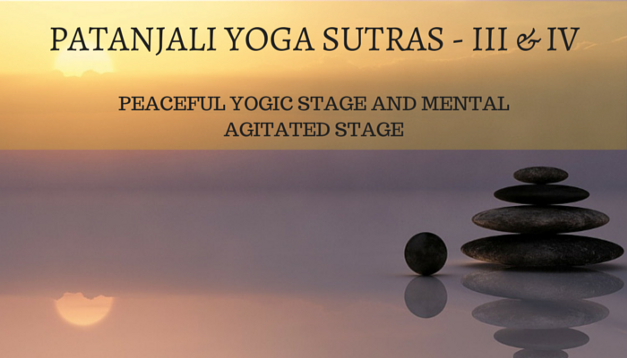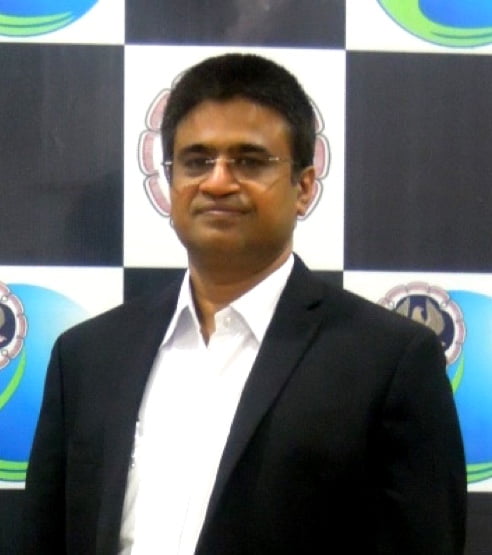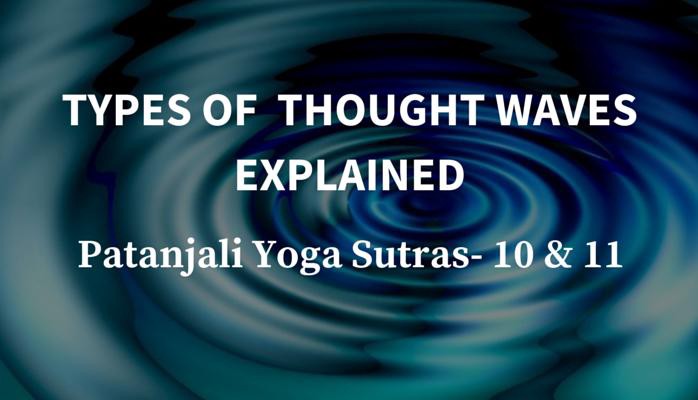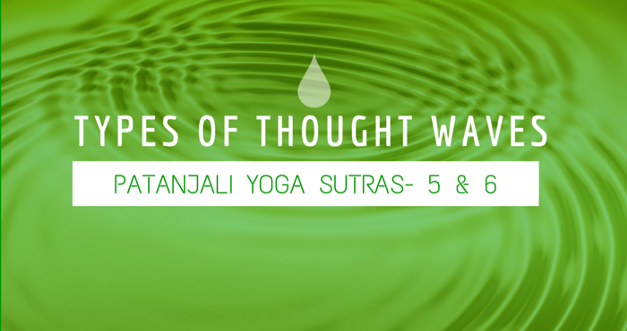In the first two Sutras we established that Yoga is self initiated restraint on the thought waves. The next Sutras explain the peaceful Yogic state that a person can be in.
तदा द्रष्टुः स्वरूपेऽवस्थानम्॥३॥
Tadā draṣṭuḥ svarūpe’vasthānam||3||
1.3. At times there is union of the thoughts and the physical state of the environment with the Self.
1.3 Then through perfect vision, the actual self sees and settles in tranquility vis vis thoughts.
वृत्तिसारूप्यमितरत्र॥४॥
Vṛttisārūpyamitaratra||4||
1.4. At other times, the reality is not the same form as the thought-streams, leading to Vritti.
1.4 At other times the self and the thoughts are in conflict (vritti ) with the reality.
The human mind is always filled with thought waves. These thought waves keep coming one after another non stop. Normally, thoughts raise a situation that is completely aligned and synced with reality. When thoughts are in complete union with the reality, it brings peace in the person. That sort of bliss, release and tranquility is to be experienced and felt. It is very difficult to explain and share this feeling. A person with aware state of mind is able to experience and understand this union. The union of thoughts with the real.
In plain words, the thought waves form a vision in our mind. When this vision syncs with the real environment or situation, it builds harmony and removes the conflict. Then there are no negative feelings and happiness prevails.
Human mind is programmed to have thoughts without a pause, interruption or respite. If you had watched a child closely, you can see it sometimes smiles, frowns, etc. These expressions reflect the thoughts going on in the mind. These thoughts keep crisscrossing in the mind of a child. Some of these thought waves are easily reflected via the face. These thought waves keep coming even to a child without a break. While in adults, the speed of the thought waves is even faster. This is because adults are more informed and knowledgeable about the environment .
There are many descriptions available for these aphorisms (Yoga Sutras) by learned experts. Drasta means SEER, unattached vision, indifferent to happenings, detached attachments. Such concepts and words may sound pretty difficult to grasp now. I am leaving these complicated concepts and annotations to be understood via the later sutras. By that time, readers will be aware of many of these concepts and better understand them.
To understand better the meaning of two sutras above, it is necessary to understand the relation of thought waves with the reality. As long as the thought waves are aligned to the actual environment and happenings, the person is able to find balance. He is at complete peace. He relates to these thought waves and stays in perfect harmony. He is unified with the existence and is in a state of bliss. This is known as the state of Yogic union. It occurs always subconsciously on and off.
However, there are times when thought waves generate feelings of discomfort. These types of thought waves are not aligned with the reality and result in mental disturbances. These surreal thought waves are responsible for creating illusory experiences. Even though a person might be comfortable in the outside environment, he is agitated from the inside. There is a feeling of turmoil within him.
This whole process of seeing is inside, and not outside like seeing the physical world with naked eyes. It is a multidimensional and a multifaceted vision. It adds every experience that a person has had, every value that has been inculcated and every imagination that has been made.
You have heard the phrases like, dream come true. This is the sort of feeling when you are in union with existence. This is called the state of yoga. You are now in a pleasant state of consciousness. This state is attained by an individual at the mental level. Being a non physical realm, this state is not related to physical status.
Say, you had longed for a perfect holiday. Then one day, you got a chance to fulfill that dream holiday on a yacht with your friends. For a sufficiently long time. The very thought of that holiday, you enjoyed long ago, generates a blissful feeling of contentment and peace.
Similarly, there may have been other unpleasant incidents that have happened in your life. Thought waves about those unpleasant incidents generate negative feelings. These thought waves get intertwined with other thoughts. As a result, a person keeps experiencing the same feelings, without a pause. It is nothing but an illusion of mind. It is a distorted reality.
Identifying oneself with the illusory thought waves and getting immersed in the false feelings is a non yogic state. Completely dissociating oneself from these negative thought waves is the key. One has to remain completely indifferent and non-judgemental to these thought waves.
Witnessing these thought waves as an onlooker and observer is called yogic state. One should look at those thoughts come and go just as a bystander sees the traffic without disturbing the inner self in the state of yoga. As clouds keep changing their forms in the sky, so do these thought waves.
To Sum Up
A person should program his mind steadily. He should remain aware of each thought wave passing by. As a yoga practitioner, he should be able to link and unlink himself from his ever popping-up thoughts. He should learn to remain unaffected by the unpleasant illusion that these thoughts can create.
The process to achieve this yogic state is explained in a step by step process. It is very easy to follow this process and practice it. It is not about renouncing the world or being an ascetic. It is an easy way to live a successful life full of happiness. I look forward to sharing those secrets with you in the coming weeks.



